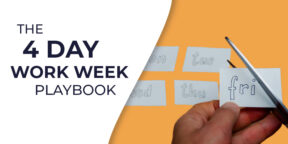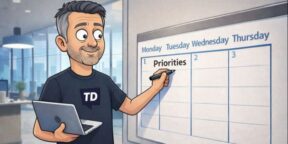Imagine starting a new role. There’s a new team and technology to get to know, new workflows and expectations to align with – all the standard stuff. But instead of having five days to absorb it all (and prove yourself), you’ve only got four.
At Today Digital, we’re proud to be pioneers of the four-day work week. We don’t think of it as a perk – it’s how our team works best, stays focused, avoids burnout, and keeps time aside for life. But it also means we can’t rely on the standard “you’ll find your feet eventually” approach to new hire integration. We needed to rethink our strategy entirely.
In doing that, we learned that successful four-day work week onboarding isn’t about squeezing more stuff into less time. It’s about streamlining efficiency, with concepts like the “MoSCoW” method, human-led buddy systems, and the right tech.
So, here’s how we built our approach to onboarding for the four-day work week, and what we learned along the way.
Four-Day Work Week Onboarding: The Challenge
Despite endless studies showing us how important onboarding is, most companies still think of it as an afterthought. Strong onboarding can improve new hire retention by 82%, and reduce the number of “non-starters” teams have to deal with. But the process isn’t easy, particularly in an organization with a remote-first structure, and a four-day work week.
Face-to-face time with colleagues and managers is restricted to a handful of Teams calls. High-performance employees are focused on their own tasks. The tempo of the workplace is sharper too, with tighter feedback loops, higher expectations, and less room for drift.
Companies can’t just retro-fit traditional onboarding strategies into a new setup. Even just embracing remote and hybrid work delivers challenges – with 63% of flexible workers left feeling undertrained after an onboarding journey. Cut the standard five-day work week down to four, and you end up with even more chaos.
Rob Scott says: ““A four-day week isn’t just shorter. It demands sharper intent. If you don’t redesign your systems, you’ll just end up working badly in less time.”
What companies need from four-day work week onboarding is a new strategy that matches the way they actually work now: focused, async-friendly, outcome-driven, and full of real human interaction, even if you’re rarely in the same room.
It sounds complicated, but honestly, compressed schedules and hybrid work can lead you in one of two directions. You can either end up derailing new hire integration, or you can use remote onboarding best practices, and real strategy to accelerate employee success.
Today Digital’s Approach to Four-Day Work Week Onboarding
So, where did we get started? The obvious place.
We looked at what wasn’t working. Vague intros. Loosely defined ramp-up goals. “Let’s circle back in a week” check-ins that never happened. That kind of stuff doesn’t hold up when every week is shorter and faster-paced.
Then we started changing the foundations.
At Today Digital, we don’t see onboarding as an admin task. It’s not paperwork, logins, and hoping someone in IT remembers to add you to the right Slack channels. For us, onboarding is a product. One we’re constantly refining, just like everything else we offer.
We’re not trying to fit five days of work into four. We’re asking: What would onboarding look like if the four-day week was the starting point, not the constraint? That question led us to build something more focused, more human, and more effective.
1. Clarity Starts Before Day One
Four-day work week onboarding demands elevated clarity, and that means getting ahead of the start date for any new hire. Pre-boarding is part of the process.
Every new hire gets access to the Bob platform before day one, where they’ll find intro materials, team bios, editorial standards, and a short, human “Welcome to Work at Today Digital” guide that walks through how we actually operate.
From the first hour on day one, they’ve got access to a clear 30/60/90-day success framework. The team walks through role-specific goals using the same OKR thinking we use everywhere else; this is borrowed directly from our editorial and publishing teams.
Rob Scott says: “You can’t expect someone to perform at a high level if you don’t tell them what success looks like. Onboarding should remove friction, not create more of it.”
That clarity helps people move quickly, but with confidence. They don’t spend week one figuring out where they fit. They start doing, with context.
2. The Buddy System: Building Connections
We don’t just have compressed work weeks at Today Digital, we’re a team of remote workers – and we know remote work can lead to confusion and isolation. That’s why we start building human connections immediately, matching new hires to relevant “buddies”.
Often, we find that the fastest way to build cultural fluency isn’t through a manager. It’s through a peer. Buddies help bridge the human stuff, like how to actually prepare for one of Rob’s editorial check-ins, or what “done” means in a product-led project. They reduce pressure on managers, and honestly? They make onboarding feel less isolating.
It’s something our team consistently calls out as valuable, for instance, Francesca Savidge noted that she sees Today Digital as a place where “people are encouraged to succeed together, and learn from each other.” That’s exactly the vibe we’re going for.
3. Tech-Enabled, Human-Led
As a remote-first company, we rely a lot on tech: Monday.com, Microsoft Teams, HubSpot – all the basics. But we don’t treat tech as the solution. It’s just the channel.
Our onboarding blends async resources (documents, checklist templates, intro videos) with scheduled, high-context conversations. People know when they’re meeting their manager, when their buddy check-ins are happening, and when their first team retro is scheduled.
We also help teach new employees how to use cutting-edge tech to simplify and streamline workflows, with things like our “AI Lab” teams channel, for tips on prompting, and using AI-powered resources to save time.
As our founder Rob Scott says: “In a four-day work week, we can’t afford to leave new hire success to chance. Every interaction, every resource, every relationship matters more when time is compressed.”
The ROI of Intentional Four-Day Work Week Onboarding
Making the four-day work week work requires a conscious approach to everything, from meetings, to tech deployment, and onboarding. Implementing these strategies has led to real results for our team.
- Time-to-impact is faster. New hires ship real work sooner. Our editorial team now sees bylines and coverage in week two, not week four. Our sales team sees deal contributions inside the first quarter.
- First-6-month retention has increased. Not just because people feel welcome, because they’re confident. Confidence drives momentum.
- Manager workload drops after onboarding. Structured onboarding shifts the load from reactive to proactive. We spend more time upfront, and save far more on the back end.
- Satisfaction scores from new hires are high, and consistent. In a recent internal pulse survey, over 90% of new joiners said they “felt set up for success within their first two weeks.”
All of this feeds into long-term outcomes. The better your onboarding, the less friction your team carries later. In a four-day setup, that really matters.
Rob notes: “We measure the impact of onboarding the same way we measure content or campaigns. Are people producing great work, fast, and do they feel confident doing it?”
Plus, it plays into hiring competitiveness too. A lot of companies talk about flexibility and employee-first cultures, but when candidates dig into your actual onboarding experience, that’s where they get a real feel for what you have to offer.
Remember, scaling a business isn’t just about adding headcount. It’s about building systems that help people deliver quickly, with clarity. Onboarding is one of those systems. If you’re not putting intention into it, you’re probably losing time, trust, and talent without realizing it.
The Four-Day Onboarding Tips Any Team Can Steal
Whether you’re running a four-day work week already, or you’re thinking about making the shift, there are a few simple changes you can make right now that will improve how people land in your company. Here are some quick tips, based on our experience:
- Front-load the investment: We used to think onboarding happened during the first week. Now we see it starts before it. Get the basics sorted: tech access, welcome guide, success metrics, and team context. This sets the tone. If your pre-boarding is thoughtful, people assume the rest of the culture is, too.
- Measure what matters: People want to do good work, early. Help them define what “good” looks like. Every new hire at Today Digital has role-specific OKRs by day one. You don’t need a 20-page onboarding doc, but you do need a clear scoreboard. It’s one of the best employee retention strategies we’ve used: remove ambiguity, and watch confidence grow.
- Pair tech with humanity: Video conferencing platforms and file sharing apps are great, but they won’t make someone feel truly included. Schedule real conversations. Give people a buddy. Create space for human texture, especially in a remote onboarding setup.
Onboarding for the Future
In our opinion, compressed, flexible work weeks are the future – and our teams agree. They say our approach gives them the “flexibility and autonomy” they need to build a career that blends fully with their lives, and we love that. But your strategy for integrating staff into this new environment matters.
If you’re serious about flexibility, you have to be serious about new hire integration. Because nothing undermines your culture faster than talking up autonomy, then giving people no direction. Or claiming people-first values, then leaving new hires to figure things out alone.
At Today Digital, we don’t get everything perfect. But we’ve built an onboarding model that reflects how we really work. It’s structured, efficient, personal, and constantly evolving. It makes the most of the time we choose to work, not just the time we think we have to fill.
Want to be a part of this kind of workplace? Explore the careers available at Today Digital today. Or, if you’re looking for more advance as a business leader, connect with our HR team.











